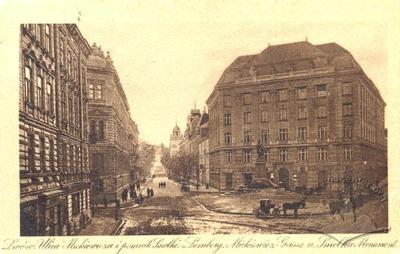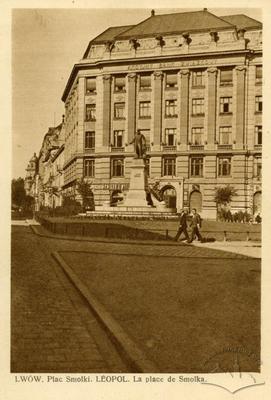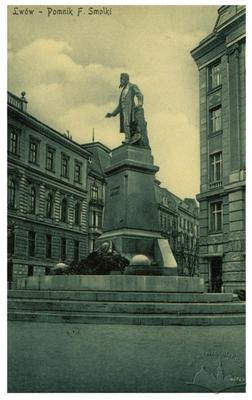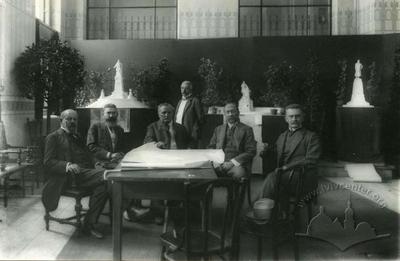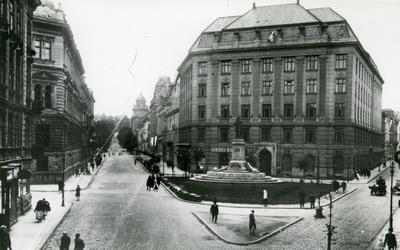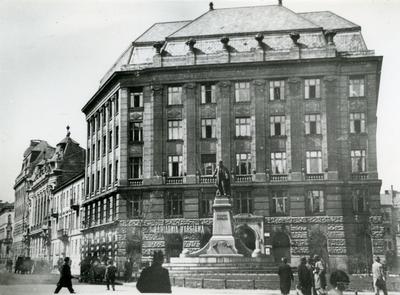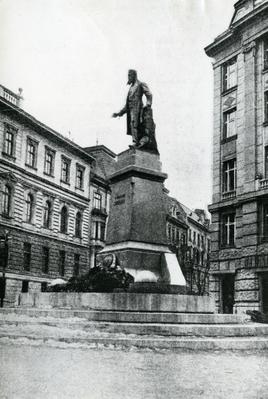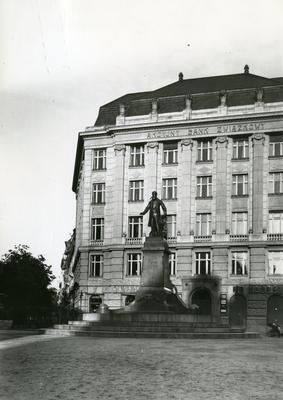
Pl. Henerala Hryhorenka – monument to Franciszek Smolka (does not exist) ID: 103
A monument to Franciszek Smolka, a Polish politician and a resident of Lviv, was installed on the square by sculptor Tadeusz Błotnicki in 1913 and dismantled in 1946.
Story
This square was formed in the early 19th c. and named Jezuicka or Pojezuicka. In its middle, there was a well, later transformed into a fountain with a stone vase in the center, and a small public garden. In 1885 the square was named after Franciszek Smolka (1810-1899), a resident of Lviv and a Polish politician, who for many years lived in a house on this square (now in its place there is a house on pl. Hryhorenka, 4). A participant in the Spring of Nations, he fought for the Polish autonomy within the Habsburg Empire and was sentenced to death in 1848. After he was pardoned, Smolka continued to defend the rights of the Polish community as a deputy to the Galician Sejm. He was the president of the Imperial Council in Vienna. In the 1860s, it was he who initiated the creation of the Lublin Union Mound in Lviv (pol. Kopiec Unii Lubelskiej) to honour the Union's 300th anniversary.
The idea to establish a monument to Franciszek Smolka arose after his death in 1899. In 1912 a contest was held for the best design of the monument. The first place was won by a project designed by Jan Raszka, a Krakow sculptor. However, many Lviv residents, in particular sculptors and architects, did not agree with the terms and conditions of the contest. After a lengthy public debate, another project, designed by Tadeusz Błotnicki, a Lviv sculptor, was implemented. The monument was cast in Vienna after a plaster model.
The monument was dismantled in 1946. Today there is a monument there to the law enforcement officers of Ukraine, who died in the performance of their official duties; it was set up in 1999.
Architecture
Franciszek Smolka was depicted as a speaker leaning against the ruins of the Vysokyi Zamok (High Castle) with his left hand and extending his right hand forward, turning to the audience. The full-length bronze statue was placed on a high granite pedestal. The monument's background was the house on pl. Hryhorenka, 2, now occupied by the regional department of the Ministry of Internal Affairs.
Related buildings and spaces
Sources
- Jan Tarczałowicz, "W sprawie pomnika Smolki", Sztuka, Zeszyt 1, Lwów, 181-184
- "Protest Koła Architektów", Sztuka, Zeszyt 1, Lwów, 1911, 184
- "Protest Towarzystwa upiększenia miasta Lwowa w sprawie pomnika Smolki", Sztuka, Zeszyt 1, Lwów, 1911, 184
- "Z tow. upiększenia m. Lwowa", Sztuka, Zeszyt 1, Lwów, 184
- Stanislaw Roman Lewandowski, "Protest w sprawie pomnika Smolki", Sztuka, Zeszyt 1, Lwów, 1911, 185
- Dr. H. B., "Pomnik Fr. Smolki", Kurjer Lwowski, 25/09/1912, № 440, s. 4
- Józef Białynia Chołodecki, Franciszek Smolka, (Lwów Piller-Neumann, 1913), 82
Urban Media Archive Materials
